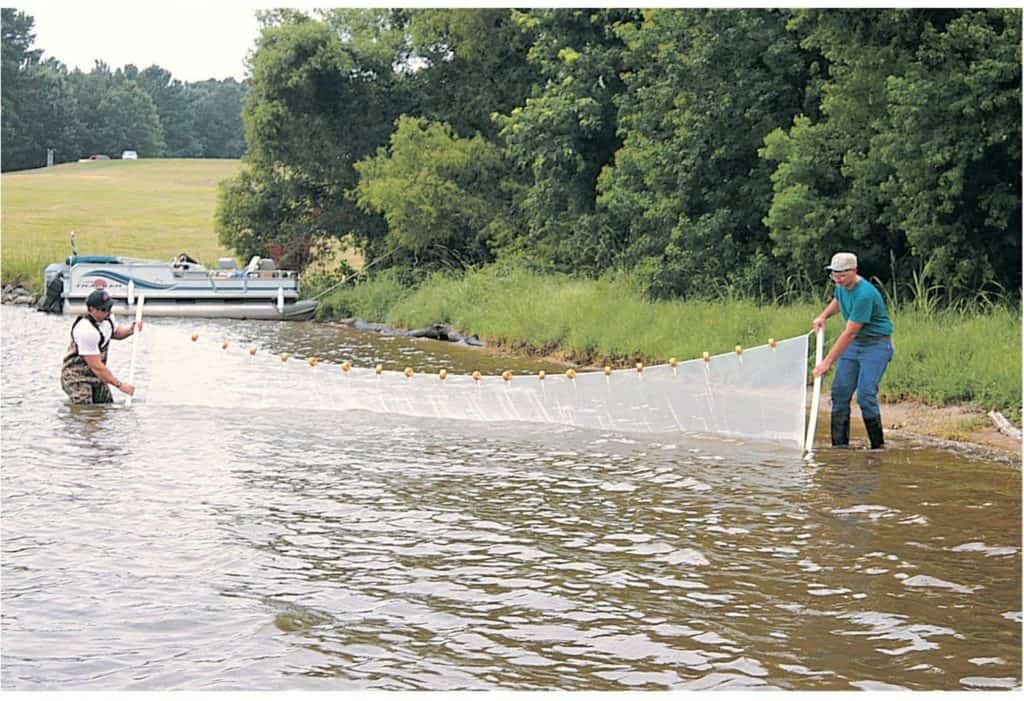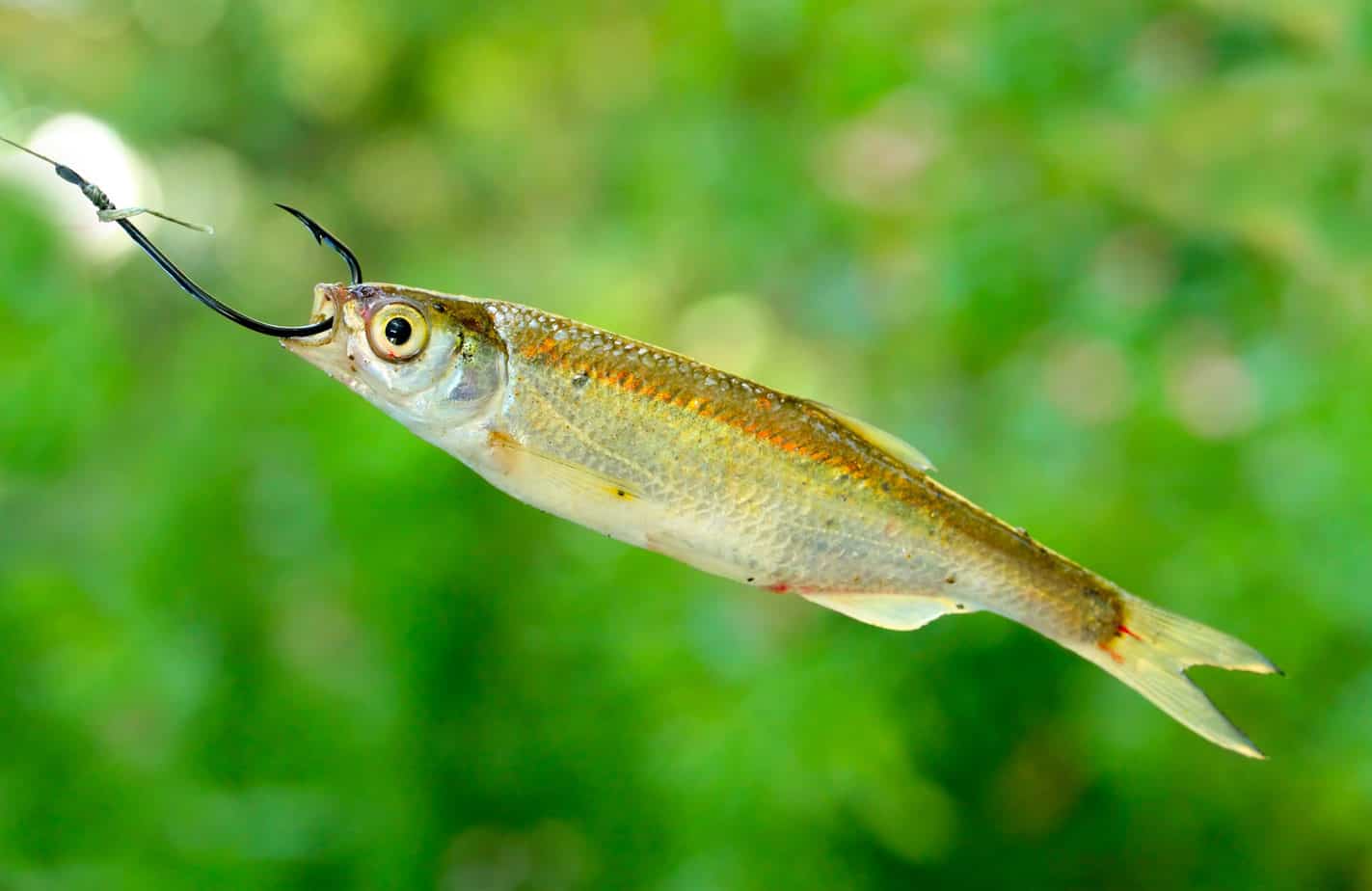The dog days of summer are usually considered one of the more forgettable times of the year.
However, for those who love to fish creeks for smallmouth, rock bass, and other game fish, this is an optimal time to get out. The long, hot days mean lower water levels and great fishing holes.
Growing up fishing these creeks, we would use a plethora of different baits. Our favorite by far, though, was live minnows.
While many people prefer to purchase minnows from a bait shop, the availability and quality often leave much to be desired.
Many people do not know you can easily catch an abundance of baitfish (and even some crawfish and hellgrammites) simply by seining for them yourself.
In a nutshell, this is how you seine for baitfish:
- Find a smaller feeder stream or shallow area of a main creek with “holes” that will hold minnows
- Use two people to spread out your seine
- Set the poles at a 45-degree angle, allow the weights to drop
- Cover entire chokepoint with net
- If you have extra bodies, have them push the minnows by walking them towards the seine
- Finally, rotate the bottoms of the seine poles to orient the net horizontally
- Retrieve your bait
Now, let’s get into the details.
What is Seining?
Seining is a method of fishing that utilizes a net called a seine. This net is unique in that it is vertical in the water or held at a steep angle with weights holding the bottom down while the top is kept floating by corks or foam floats.
While these are commonly found deployed on an industrial scale on fishing liners and can be hundreds of yards in length, they can also be very small and simple – easily managed by one or two people.
The legacy of seining is a long one, going all the way back to the Stone Age where native peoples would use crude nets made of plant fibers and stones to catch fish for their communities.
Today, while we have more efficient means of seining, the basic blueprint has changed very little throughout the ages. Although this method of catching fish is hardly the most popular nowadays for the average angler, it offers tremendous upside as a means of securing high-quality baitfish.
What’s more, you can easily seine for minnows in the shallower and narrower parts of the stream you plan on fishing, eliminating the need for the hassle of purchasing bait at retailers.
What You Need

The idea of catching your own bait may seem a bit intimidating at first. It can come across as a lot of unnecessary work, and people may find the learning curve a bit off-putting.
There is certainly a bit to learn, but the upside of acquiring and developing this skill can pay huge dividends. Moreover, I cannot stress enough just how fun it is to seine for minnows – and this goes double for kids who are just learning the fishing game.
Some of the fondest memories are seining minnows with my grandfather and brothers at dawn in Little Rush Creek in southern Ohio. We would seine minnows for 20 minutes, catch 100 minnows, and spend the rest of the day reeling in incredible Smallmouth as we walked the 3 mile stretch up the creek.
Parents looking for a fun family activity can’t go wrong doing this, and you don’t need much to get started. You can usually do so for less than an initial $100 supply investment.
To get started seining minnows, you’ll want to invest in 3 relatively inexpensive items. The first is the seine itself.
These come in about as many different sizes as you could imagine, but for the purposes of seining minnows it is a good idea to stick with the 4 foot by 15 or 20 foot nets.
These can be purchased at a variety of different outdoor retailers and generally run from about $40 – $60 depending on the quality you’re seeking.
Generally, these nets are made of durable polyethylene or nylon fiber and designed to hold its own when it comes to wear and tear. The nets holes will usually also be very fine as to allow water to easily pass through without allowing any fish a chance to escape.
Next, you will want to invest in a great pair of seine poles. These poles will be attached vertically to each end of the net and allow for the seine to be spread out evenly through the water from the bottom of the stream to the surface.
When seining, each pole is typically handled by a separate person, allowing both individuals to maneuver the net into position or expand or contract the width.
While the poles we grew up with were wooden and measured in around 48”, today’s seines also come in aluminum varieties that are also collapsible from 37” to up to 54”, offering increased convenience for transport. And at an average price of $20, these poles pay for themselves pretty quickly.
Finally, you need a place to store all the bait you catch. This is where having a great live bucket comes into play.
There are many options available to keep live minnows, but I recommend the old-school method of using a minnow wade bucket.

Frabill Wade Bucket
Made of galvanized steel, these 2 quart buckets are designed with your baitfish in mind, but can also store worms, crayfish, salamanders and just about any other kind of bait you can think of. Being made of metal, its durability is second to none.
The design features a solid bucket with a second porous bucket within that is removable. When you lift the internal bucket, the water drains out of the holes allowing you to access the bait without water interfering, ensuring you don’t have to spend too much time wrangling the bait.
What’s more, these buckets are easy on the wallet. A quality wade bucket can be purchased for under $20 in most cases.
Tricks of the Trade

Seining for minnows doesn’t require a whole lot of experience to fill your bucket, but there are a few strategies that will help. First, wear clothes that you don’t mind getting wet, as seining for minnows require you to wade in the water.
Chest waders are fine, but be sure that you won’t be falling into an unexpected hole which could be potentially dangerous. An old pair of gym shoes or water shoes work just fine. Ideally, 3 or 4 people is the perfect team to get started.
Start by either finding smaller streams that feed into a main creek, or find shallow areas of a main creek that have turned into “holes” that will hold minnows. With 2 people, spread out your net 5 to 10 feet, each person holding one of the sein poles.
Try finding chokepoint areas in the stream or hole that will be easy to funnel fish through. Once the point has been established, set the poles at a 45-degree angle, allowing the weights to sink the net to the bottom while the top of the net floats on the surface.
Be sure the net covers the entire chokepoint so that no fish is able to escape above, under, or around the net.
Once the seine is in place, have the others in your party walk through the water towards the net from the opposite side of the hole or creek, no further than 10-15 feet.
It is a good idea to walk abrasively through the water and in unison. Think of it as if you are trying to herd cattle and funnel them all into the net. Kicking over rocks is also recommended to kick up any crawfish or hellgrammites.
Once the “herders” approach the net, the two-pole men should abruptly raise the bottoms of the poles out of the water so that the net is now horizontal above the surface of the water. If done correctly, there should be several minnows caught in the net.
At this point, the herders can gather the minnows and drop them in your wade bucket before moving on to your next hole or chokepoint. Repeat this process in different areas until you have figured out a way that works for you.
Don’t worry if the first few times are fruitless. Eventually, you will get the hang of it and it will be productive.
Conclusion
The art of seining is embraced by few these days, but it is a great skill to have and to pass on to others.
Being able to seine for your own bait guarantees you will have fresh, active live bait to use for your entire day while allowing you to save time and money at the bait shop.
Not only that but for a small investment it gives you and your friends or family a chance to have a blast doing something that you love and can enjoy for years to come.

